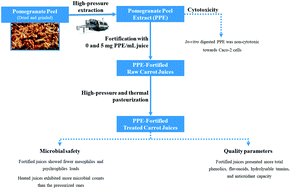Study of viability of high pressure extract from pomegranate peel to improve carrot juice characteristics†
Abstract
Extracts from fruit processing by-products usually present high amounts of bioactive compounds with several important activities such as antioxidant and antimicrobial capacities. In this work we studied (i) the cytotoxicity profile of pomegranate peel extract and (ii) safety and quality aspects after incorporating this extract in carrot juice – a beverage with low antioxidant potential and highly prone to microbial growth. The extract was obtained by high-pressure extraction and was non-cytotoxic towards the Caco-2 cell line after in vitro digestion. The non-cytotoxic pomegranate peel extract was added to carrot juice in a concentration of 5 mg mL−1. Fortified juices were processed by high-pressure and conventional heat and stored under refrigeration. On the 28th day of storage, microbial counts in PPE-fortified juices were reduced by 1.0 log10 CFU mL−1 and the pressurized juices showed significantly fewer counts than the thermal-treated ones. Just after processing, phenolic and flavonoid contents, as well as ABTS and FRAP antioxidant capacities, increased 3.6, 3.5, 8.2, and 9.4-fold, respectively in the fortified juices. The extract addition did not affect any colour parameter and all studied physicochemical parameters i.e. total soluble solids, pH, colour, total phenolics, flavonoids, hydrolysable tannins, and antioxidant capacity remained constant throughout storage. These findings could pave the way towards the development of safe beverages with improved bioactive properties.



 Please wait while we load your content...
Please wait while we load your content...